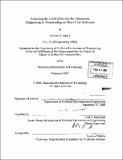Assessing the level of service for shipments originating or terminating on short line railroads
Author(s)
Alpert, Steven M
DownloadFull printable version (5.229Mb)
Other Contributors
Massachusetts Institute of Technology. Dept. of Civil and Environmental Engineering.
Advisor
Carl D. Martland.
Terms of use
Metadata
Show full item recordAbstract
This thesis measures railroad freight trip time and trip time reliability for freight rail shipments involving short lines in 2006. It is based on an underlying MIT study commissioned by members of the short line railroading industry, including the American Short Line Rail Road Association, and RaiLinc Corporation, a company that provides many railroad-related services. The data for this thesis is provided by several short lines through RaiLinc Corporation, which gathers and releases the data. Data from a 90-day window is gathered for 39 shipping lanes spread amongst several short line railroads, with a total of 6,747 movements analyzed. In addition, two shipping lanes of 69 total movements that were provided for preliminary analysis are presented in greater detail. Two short lines have also provided their own multiyear data on car movements. The significant result of this thesis is that there is an average time from shipper to customer of 8.3 days per load, with a standard deviation of 4.3 days. There is an average 2-day percentage, or highest percentage of loads to arrive in any 2-day window, of 44.7%. These numbers represent a moderate increase in trip time and trip time unreliability from the 1990-1991 numbers presented by a 1995 trip time study.
Description
Thesis (S.M.)--Massachusetts Institute of Technology, Dept. of Civil and Environmental Engineering, February 2007. Includes bibliographical references (p. [79]-[84]).
Date issued
2007Department
Massachusetts Institute of Technology. Department of Civil and Environmental EngineeringPublisher
Massachusetts Institute of Technology
Keywords
Civil and Environmental Engineering.